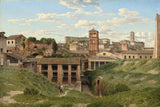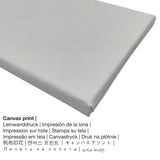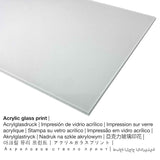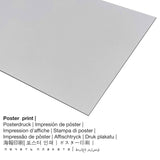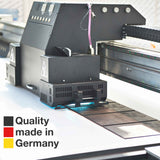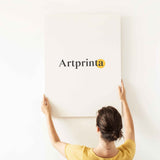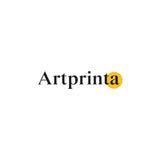Christoffer Wilhelm Eckersberg, 1814 - Echiche nke Cloaca Maxima, Rome - ọmarịcha akwụkwọ nka.
Ụtụ gụnyere. Mbupu gbakọrọ na ndenye ọpụpụ.
Nkọwapụta nka nka mbụ sitere na ụlọ ngosi nka (© - nke National Gallery of Art - www.nga.gov)
In 1803, at the age of 20, Christoffer Wilhelm Eckersberg went to Copenhagen to study at the Royal Dutch Academy of Fine Arts. After a sojourn in Paris, where he studied with Jacques-Louis David (1748–1825), and Rome, where he became part of a group of international artists engaged in the practice of plein air painting, he returned to the Royal Dutch Academy, first as professor and later director. Eckersberg is often referred to as the father of Danish painting for his influence on the generation of young artists who would come to be associated with the Golden Age of Danish painting during the first half of the 19th century.
Much of what we know about Eckersberg's working methods comes from the artist himself. In addition to the many letters he wrote from abroad, he authored two books on perspective and kept extensive personal diaries. During his stay in Rome, Eckersberg wrote of his work in a letter to his friend J. F. Clemens, "I intend to make a collection of the most beautiful of the many picturesque parts of Rome and the surrounding area. I have been working on them throughout the spring. I have already almost half a score of small sketches finished, all of which were completed on the spot after nature. I limit myself especially to architectural things." Painted in 1814, View of the Cloaca Maxima, Rome comes out of this experience of painting from direct observation. Although the artist himself refers to such paintings as sketches, the highly finished surface and meticulous brushwork of this painting suggests otherwise. Recent scientific examination has revealed extensive graphite drawing underneath the paint layer. Nevertheless, the painting conveys a feeling of immediacy, freshness, and sense of place typically associated with plein air practice.
Remarkable for its attention to detail and unusual viewpoint, the focus of View of the Cloaca Maxima, Rome seems to be on the architectural lines and their articulation of the pictoral space rather than on the famous buildings themselves. Landmarks are difficult to spot—the ancient Roman sewer system nestled beneath the hillsides in the center foreground, the Janus Arch to the left and the San Giorgio Church to the right in the middle ground, and the Campidoglio in the background. The tension created by Eckersberg's interest in linear perspective and nature study, a bridge of sorts between 18th- and 19th-century thought, is eased by the quiet Mediterranean light that bathes the scene.
Eckersberg exhibited this picture in 1828 as a pendant to his Panorama of Rome through Three Arches of the Colosseum (Statens Museum for Kunst, Copenhagen). Along with that famous work, View of the Cloaca Maxima, Rome is one of his true masterpieces of landscape painting.
Data ndabere na mpempe nka
| Aha eserese: | "View of the Cloaca Maxima, Rome" |
| Nhazi nka: | sere |
| Okwu mkpokọta: | nkà nke oge a |
| Nhazi oge: | 19th narị afọ |
| Emepụtara na: | 1814 |
| Ogologo afọ nka nka: | 200 afọ |
| Usoro nka izizi: | mmanụ na kwaaji |
| Akụkụ nke nka nka izizi: | 31,8 x 47,4 cm |
| Egosiputara na: | Nnukwu osisi nke Art |
| Ebe ebe ngosi nka: | Washington DC, Njikota Obodo Amerika |
| website: | Nnukwu osisi nke Art |
| Licensedị ikike: | ngalaba ọha |
| Site n'aka: | National Gallery of Art, Washington |
Tebụl nkọwa omenkà
| Aha onye nka: | Christoffer Wilhelm Eckersberg |
| okike onye nka: | nwoke |
| Obodo onye nka: | Danish |
| Ọrụ nke onye na-ese ihe: | onye na-ese ihe |
| Mba onye si: | Denmark |
| nhazi ọkwa: | omenkà nke oge a |
| Ụdị nka: | Ihe ngosi |
| Afọ ọnwụ: | 70 afọ |
| Amụrụ n'afọ: | 1783 |
| Ebe amụrụ onye: | Blaakrog, Varnaes, South Jutland, Denmark |
| Nwuru: | 1853 |
| Obodo ọnwụ: | Copenhagen, Denmark |
Nkọwapụta ngwaahịa
| Nkewa edemede: | ọrụ mgbidi |
| Usoro mmeghari: | dijitalụ mmeputakwa |
| Usoro nhazi: | UV kpọmkwem obibi |
| Ihe ngosi: | German mmepụta |
| Ụdị ngwaahịa: | mmepụta ihe na-achọ |
| A na-atụ aro iji ngwaahịa eme ihe: | mgbidi gallery, mgbidi ndozi |
| Ndepụta: | usoro odida obodo |
| Ụdị anya: | ogologo: obosara 3:2 |
| Akụkụ onyonyo pụtara: | ogologo bụ 50% ogologo karịa obosara |
| Akwa ngwaahịa dị: | Mbipụta kwaaji, mbipụta enyo acrylic (nwere ezigbo mkpuchi iko), mbipụta akwụkwọ mmado (akwụkwọ kwaaji), mbipụta ọla (aluminium dibbond) |
| Mbipụta kanvas (akwa akwa n'elu etiti ihe ndọtị) ụdị nha dị iche iche: | 30x20cm - 12x8", 60x40cm - 24x16", 90x60cm - 35x24", 120x80cm - 47x31", 150x100cm - 59x39" |
| Mpempe iko acrylic (nwere ezigbo mkpuchi iko) nha dị iche iche: | 30x20cm - 12x8", 60x40cm - 24x16", 90x60cm - 35x24", 120x80cm - 47x31", 150x100cm - 59x39" |
| Mbipụta akwụkwọ mmado (akwụkwọ kwaaji): | 60x40cm - 24x16", 90x60cm - 35x24", 120x80cm - 47x31" |
| Mbipụta nke aluminom (ihe aluminom): | 30x20cm - 12x8", 60x40cm - 24x16", 90x60cm - 35x24", 120x80cm - 47x31" |
| ụba: | enweghị etiti |
Họrọ nhọrọ ihe
Anyị na-enye ụdị dị iche iche nha na ihe maka ngwaahịa ọ bụla. Họrọ nha na ihe kacha amasị gị n'ime nhọrọ ndị a:
- Kwaaji: A UV printed canvas stretched on a wood stretcher frame. The canvas creates a lively and pleasing look. The great advantage of canvas prints is that they are relatively low in weight, which implies that it is easy to hang up your Canvas print without extra wall-mounts. Hence, a canvas print is suited for any type of wall.
- Bipụta na iko acrylic na-egbuke egbuke (nke nwere ezigbo mkpuchi iko): An acrylic glass print, which is sometimes referred to as a plexiglass print, will transform the original artwork into brilliant décor. The artwork is manufactured with the help of modern UV printing technology. This makes vivid, impressive colors. The plexiglass protects your chosen art replica against sunlight and heat for many years.
- Mbipụta nke aluminom: An Aluminium Dibond print is a material with an outstanding effect of depth. A non-reflective surface creates a modern impression. The bright & white sections of the work of art shimmer with a silky gloss, however without the glare. The colors of the print are bright and luminous, the details are crisp and clear.
- Akwụkwọ mmado na ihe kwaaji: The poster is a printed canvas with a slight surface structure. Please note, that depending on the absolute size of the canvas poster print we add a white margin of approximately 2-6cm round about the print to facilitate the framing with your custom frame.
Ngwaahịa nka
a nkà nke oge a ihe esere ihe nka onye n’ezie nwe- Christoffer Wilhelm Eckersberg in 1814. Emere eserese ahụ na nha: 31,8 x 47,4 cm. Mmanụ na kwaaji was used by the artist as the medium of the painting. Moveover, the artpiece is in the the collection of Nnukwu osisi nke Art, nke bụ ụlọ ngosi ihe mgbe ochie nke mba US-American na-echekwa, na-anakọta, na-egosipụta ma na-akwalite nghọta nke ọrụ nka. Site n'ikike nke National Gallery of Art, Washington (ikike ngalaba ọha).: . Ọzọkwa, nhazi nke mmepụta dijitalụ bụ odida obodo ya na oke nke 3: 2, nke pụtara na ogologo bụ 50% ogologo karịa obosara. The painter Christoffer Wilhelm Eckersberg was an artist from Denmark, whose style can primarily be classified as Realism. The painter was born in 1783 na Blaakrog, Varnaes, South Jutland, Denmark na ndị nwụrụ anwụ na afọ nke 70 na 1853.
Ihe dị mkpa: We try in order to describe the products as accurately as possible and to showcase them visually. Nevertheless, the pigments of the printing material and the printing might differ to a certain extent from the representation on your device's screen. Depending on your settings of your screen and the quality of the surface, color pigments might not be printed as realisitcally as the digital version. Considering that all art reproductions are printed and processed manually, there might as well be minor deviations in the motif's size and exact position.
© Nwebiisinka nke | www.artprinta.com (Artprinta)

